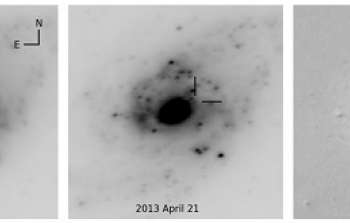sci18039 — Announcement
Game Over for Supernovae Hide & Seek
January 18, 2018
SN 2013if with GeMS/GSAOI, from left to right with linear scaling: Reference image (June 2015), discovery image (April 2013) and the image subtraction. SN 2013if had a projected distance from the nucleus as small as 600 light years (200 pc), which makes it the second most nuclear CCSN discovery in a LIRG to date in the optical and near-IR after SN 2010cu.
The Core-collapse Supernova Rate Problem, or the fact that we don’t see as many core-collapse supernovae as we would expect, has a solution, thanks to research using the Gemini South telescope. The research team, led by PhD student Erik Kool of Macquarie University in Australia, concludes that the majority of core collapse supernovae, exploding in luminous infrared galaxies, have previously not been found due to dust obscuration and poor spatial resolution. Learn more here.
About the Announcement
| Id: |
ID
sci18039
|
